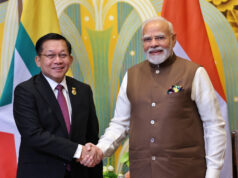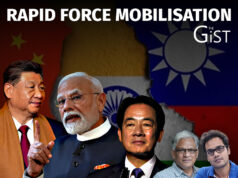The Ukraine conflict is witnessing a clash between Russia’s and Ukraine + NATO’S traditional and ‘Informatised” and “Intelligentised” forces. NATO has helped the Ukrainian war effort with high-tech weaponry and formidable ISR assets where the US had a head start.
Its precision munitions, drones, ISR capabilities and fighter aircraft were battled-tested years before and are now being upgraded with AI/ machine learning, or “intelligentised”. “Intelligentisation” is a game-changing force multiplier – fusing and operationalising colossal amounts of incoming battlefield data, rendering the battlefield transparent in real time which enables immediate target destruction upon detection, and enhancing multi-domain combat capabilities.
Russia is also innovating at exponential speeds as the Ukraine conflict drags on. President Putin had declared in 2017 already that whoever mastered AI, would rule the world. China intends to become the No. 1 AI power while building a world class military by mid-century – with the Chinese Ministry of Defense confirming that the first phase – modernising its weapons park has been completed, while its “informatization” is culminating in “intelligentisation”.
China moreover has cutting edge capabilities in 5G/quantum technologies, ensuring that it has a resilient, informatised and intelligentised defence industrial base built with domestic know-how.
In terms of systemic requirements, all three countries are developing or have developed integrated command and control systems for transforming real time situational awareness into precise military strike capabilities. But we in India have reportedly initiated work on this essential integration capability only in the maritime arena, not on our northern borders where it is most needed.
Before this Ukraine conflict, no one really knew how these diverse capabilities would fare during war. The Chinese in particular, despite their technological strides, had limited means of knowing how their weaponised AI performed in combat zones.
Enter the Russian-Ukrainian battlefield, where despite the combined resources NATO has placed at Ukraine’s disposal (total NATO defense expenditure in 2024 $ 1.47 trillion vs Russian military expenditure of $ 86 bn in 2022), Russian forces have been able to advance and decimate Ukrainian troops and NATO supplied weaponry.
While hi-tech ISR has proved to be US/NATO’s forte, Russia has shown a phenomenal capacity for innovation in EW. Russian EW has significantly degraded Ukraine’s smart-weapons’ targeting capabilities, thereby enabling it to consolidate crucial air-dominance. Western weapons such as the HIMARS, Bradleys, Abrams and Leopards have fared poorly while the Excalibur, Joint Direct Attack Munitions (JDAMs) and Ground-Launched Small Diameter Bomb (GLSDB) precision munitions have succumbed to Russian EW.
Because of these reverses, “some of the more sophisticated systems are being withheld precisely so that Russia—and through it, China—wouldn’t develop effective countermeasures”. Meanwhile both sides are deploying thousands of drones (including FPV drones) which have transformed the battlespace.
The setbacks have fuelled an acceleration of weaponised AI to enable NATO to regain the advantage in the Ukraine conflict. For example, Eric Schmidt, former Google CEO and reportedly Ukraine’s Defense Technology Advisor and major financier, is anchoring several projects integrating AI for the defence of Ukraine, including autonomous attack drone swarms (Project White Stork) and quantum/ AI technologies for navigation under conditions of GPS denial (AQNav) as he believes Ukraine can prevail on the battlefield through AI.
Palantir’s technology, which has a significant AI input, aids the successful targeting of Russian military assets. Clearview has provided facial recognition technology to Ukraine, enabling the identification of killed or captured Russian soldiers for dissemination (to sow discontent in Russia). Indeed, American mouthpieces have termed the Ukraine conflict a testbed and bonanza for the US military, a sentiment echoed by their Ukrainian counterparts who have declared they “are happy to act as the world’s R&D lab for tech”.
India Needs Defence Industrial Base, Future-Ready Command Structure
Russia has been able to withstand the combined NATO might because of its indigenous defence industrial base, tremendous innovation capacity and a reformed command structure. India too needs to build resilience for attritional wars and must approach the development of sovereign tech capabilities through a national security lens.
The army is reportedly thinking of creating 16 tech clusters on emerging technologies from sensors, quantum tech, 5G and 6G, to AI. This is laudable but on its own will not guarantee security. For this India has to (a) set up the required integrated command and control structures for data fusion from multiple sources and its conversion into military outcomes and (b) indigenously develop the underlying, fundamental technologies which give these weapons their lethality.
For example, to achieve electromagnetic spectrum dominance for EW, India needs sovereign compute capabilities, indigenous cloud and therefore indigenous AI and GPUs, 5G and quantum technologies, sensors, lasers, plus the myriads of components that constitute their supply chains.
Moreover, India has to create a Joint Centre for Data Fusion to ensure that data collected by India’s top-of-the-line satellite imagery, expensive drone and massive signals intelligence infrastructure, is converted into reliable and actionable intelligence. Joint-ness to ensure interoperable, standardised, secure, indigenous digital infrastructure across the armed forces for data fusion and use for the battlefield – has to be the first priority of the day. Otherwise, we will continue to rely on shepherds to alert us to border intrusions.
The key question is how to jump start this process given that the country is way behind its peers in critical technologies, funding for investments and procurement budgets for indigenous technologies.
The solution is to facilitate a resilient ecosystem of hi-tech innovation-driven private and public sector firms that will build deep domain expertise in specific technologies. Such firms tend to be startups and early-stage companies, not the large system integrators that supposedly build defence weapon systems/platforms mainly by white-labelling imports (which is why India is still the largest arms importer in the world).
The creation of such an ecosystem and support for a sovereign compute capability could even attract high-powered talent back to India, disincentivise others from leaving, and launch a virtuous cycle that could propel India into the front ranks of technology leaders. After all, it is largely thanks to Indian and other immigrant brains that the US is able to maintain its tech supremacy in chip design and AI, the most fundamental of technologies ensuring geopolitical power.
This would require strategic direction by the government specifically for small hi-tech firms. Firstly, for private sector capital to fund the creation of such an ecosystem – high-growth and predictable market opportunities for sub-components and sub-sub components that go into the manufacture of modern defence solutions/platforms – have to be created. A more agile defence procurement system with assured orders could achieve this.
We have for years been demanding that India replace the Defence Acquisition Procedure designed to facilitate imports with a system prioritising R&D and domestic production. Since MeitY does not have a national security mandate, it is up to the National Security authorities, Armed Forces and Ministry of Defense to forge ahead with a blueprint for building new age weapons through systemic reform, a more future-ready procurement ecosystem, horizontal and vertical sovereign tech capabilities, and proficiency in components.
Chairperson SITARA
ORKASH Labs




